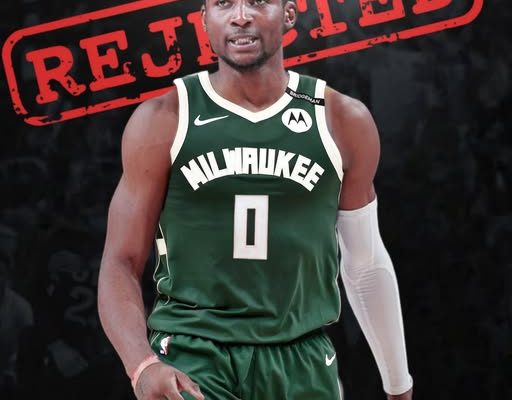The young star of the Golden State Warriors, Jonathan Kuminga, has been the subject of considerable attention in NBA circles, particularly regarding rumors linking him to the Milwaukee Bucks. This potential move has generated buzz among fans and analysts alike, as both teams have vested interests in shaping their rosters to compete at the highest level. However, despite the speculation and reported negotiations, the deal to send Kuminga to the Bucks was ultimately rejected ahead of the upcoming NBA season. This outcome is significant for several reasons, involving not only the individual player’s trajectory but also the strategic plans of both franchises as they aim to maximize their chances of success in an increasingly competitive league.
Jonathan Kuminga, a promising young forward, was drafted by the Golden State Warriors as a high-ceiling talent with immense potential. Known for his athleticism, versatility, and raw skills, Kuminga quickly became an integral part of the Warriors’ rebuilding and competitive efforts. His ability to contribute on both ends of the court, coupled with his youth and room for growth, made him a valuable asset for Golden State. The Warriors have long been associated with building around core superstars like Stephen Curry, Klay Thompson, and Draymond Green, but they have also placed a premium on cultivating young talent that can eventually complement and sustain the team’s championship aspirations.
On the other side, the Milwaukee Bucks, led by superstar Giannis Antetokounmpo, have been aggressively seeking to bolster their roster to maintain and extend their window of contention. The Bucks, having won the NBA championship in 2021, are acutely aware of the need to surround Giannis with complementary players who can elevate the team’s overall performance. Adding a versatile young player like Kuminga could have offered them the flexibility and potential to enhance their depth and future upside. Reports surfaced that the Bucks had engaged in talks with the Warriors about a trade involving Kuminga, with the intent to add another dynamic piece to their roster.
Despite the apparent mutual interest, the reported trade discussions did not culminate in a finalized deal. The rejection of the deal can be attributed to several underlying factors. For one, the Warriors have shown a strong commitment to their young core and view Kuminga as a critical part of their long-term vision. Trading him away would have meant sacrificing a player with a high developmental ceiling, which does not align with Golden State’s strategy to balance immediate competitiveness with sustainable growth. The Warriors front office likely assessed the value of Kuminga against what they could receive in return and found that the potential trade did not meet their expectations or needs.
Moreover, the specifics of the proposed deal reportedly did not satisfy either party’s strategic priorities. Trades in the NBA are complex transactions that involve not only player evaluations but also considerations of salary cap implications, contract lengths, team chemistry, and future draft assets. The Bucks, while eager to improve their roster, had to weigh the cost of acquiring Kuminga against what they might lose in terms of other players or draft picks. If the offer was not sufficiently compelling, Milwaukee might have decided that retaining their current assets and exploring other avenues for improvement was a wiser choice.
In addition, Jonathan Kuminga’s own development and potential impact cannot be underestimated. As a young player entering his third NBA season, Kuminga has shown flashes of brilliance and the capacity to be a difference-maker. His athleticism allows him to guard multiple positions and create scoring opportunities in transition, making him a valuable two-way player. The Warriors’ coaching staff and management likely believe that with continued development, Kuminga could evolve into a cornerstone player who contributes significantly on both ends of the floor. This belief in his potential would naturally discourage the Warriors from parting ways with him lightly.
The rejection of the trade also highlights the broader dynamics at play in the NBA today, where teams are increasingly cautious about moving young talent prematurely. The league has seen numerous examples of teams acquiring veteran stars at the expense of future assets, only to find themselves short on sustainable growth options down the line. Conversely, teams like the Warriors are focusing on balancing veteran leadership with the infusion of young, cost-controlled players who can mature within the system. This approach aims to create a stable foundation for long-term success rather than short-term gains that might compromise future flexibility.
For the Milwaukee Bucks, the failed attempt to acquire Kuminga signifies the challenges they face in navigating the competitive landscape of the NBA. While Giannis remains one of the league’s most dominant players, the Bucks’ ability to surround him with the right supporting cast is crucial to extending their championship window. The rejection of the Kuminga trade means that Milwaukee must continue to explore alternative avenues, whether through free agency, other trades, or the development of their own young players, to build a roster capable of contending with powerhouse teams like the Warriors, Boston Celtics, and Philadelphia 76ers.
The failed trade also invites reflection on the nature of team-building strategies across the league. Golden State’s decision to hold onto Kuminga exemplifies a philosophy centered on patience and development. The Warriors have demonstrated in recent years that nurturing young talent alongside established stars can lead to sustained success, as seen in their multiple championship runs. Conversely, teams like the Bucks, who are in a more immediate championship window with a star like Giannis, face pressure to make bold moves that can either pay off handsomely or backfire.
From a fan perspective, the news that Kuminga will remain with the Warriors is met with both relief and anticipation. Golden State fans have witnessed the growth of their young core and recognize Kuminga’s potential as an exciting player who can contribute significantly in the seasons ahead. The continuity provided by keeping Kuminga aligns with the Warriors’ identity and competitive outlook. Meanwhile, Bucks fans may feel a mix of disappointment and pragmatism, understanding that while the deal did not go through, their team remains committed to assembling a roster capable of winning championships.
In summary, the story of Jonathan Kuminga and the proposed trade to the Milwaukee Bucks, which was ultimately rejected, offers a fascinating glimpse into the complexities of NBA roster management and team-building strategies. Kuminga’s value as a young, versatile talent makes him a pivotal asset for the Warriors, who are committed to balancing veteran leadership with youth development. The Bucks’ interest underscores their urgency to add pieces around Giannis Antetokounmpo to sustain their championship aspirations. However, the inability to reach a mutually beneficial agreement highlights the intricate considerations involved in trades, from player evaluation to financial and strategic factors. As the new NBA season approaches, Jonathan Kuminga remains a key figure in the Golden State Warriors’ plans, symbolizing the potential and promise of the franchise’s future. Both teams will continue to adapt and maneuver in pursuit of success, with this rejected trade serving as a reminder of the delicate balance required in assembling a championship-caliber roster.



